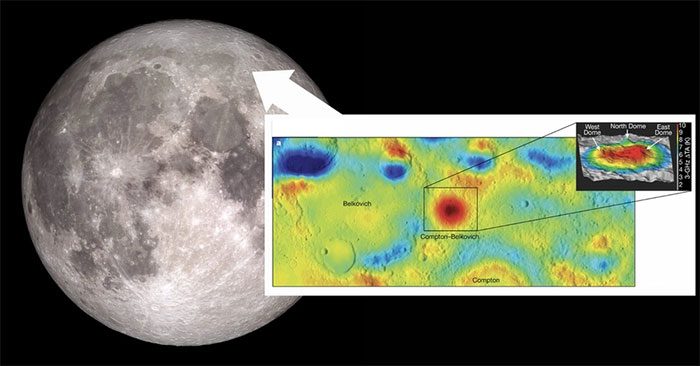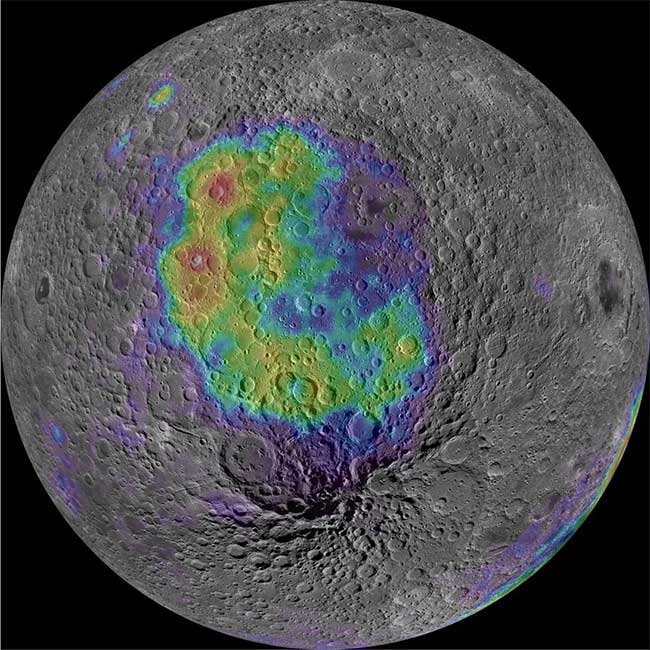On the far side of the Moon, a radioactive rock has been discovered, which may reveal hidden secrets of the Moon.
The far side of the Moon, always facing away from Earth, has long been a source of curiosity and wonder for astronomers and space enthusiasts. Unlike the familiar near side, marked by dark patches of volcanic plains known as maria, the far side is primarily covered by rugged highlands and craters. However, there is one area on the far side that stands out more than the rest, known as the Compton-Belkovich anomaly.
The Compton-Belkovich anomaly is a large circular region that appears brighter than the surrounding area in radar images. It is located near the equator, approximately 500 kilometers from the center of the South Pole-Aitken Basin, the oldest and largest impact crater on the Moon. This anomaly was first discovered by the Lunar Prospector orbiter in 1998 and later confirmed by the Lunar Reconnaissance Orbiter (LRO) in 2011.
What makes this area unusual is its chemical composition, which is rich in elements such as potassium, thorium, and uranium. These elements are collectively referred to as KREEP, an acronym for potassium (K), rare earth elements (REE), and phosphorus (P). KREEP is associated with volcanic activity on the Moon, as it is believed to have formed when molten magma from within the Moon differentiated and concentrated these elements near the surface.

A new study suggests that this mysterious hotspot has a strange origin: It may be due to natural radiation emitted from a giant buried granite block, rarely found in large quantities outside Earth.
However, volcanic activity on the far side of the Moon is much less frequent and intense compared to the near side. So how did such a large amount of KREEP end up in this remote and isolated location?
A new study published in the journal Nature may have the answer. A team of researchers from the United States used microwave data obtained from publicly released information from two Chinese lunar missions, Chang’E-1 in 2010 and Chang’E-2 in 2012, to measure the geothermal activity of Compton-Belkovich. They found that this area has a higher heat flow than the surrounding regions, suggesting that something hot and radioactive lies beneath the surface.
The researchers then used numerical models to simulate how such a heat source could form and evolve over time. They concluded that the most plausible explanation is that there is a giant granite block buried beneath the Moon’s crust that is emitting natural radiation from its decay. Granite is an igneous rock that forms when magma cools and crystallizes. It is commonly found on Earth but is very rare on the Moon, where much of the crust is composed of basalt.

The first panoramic image of the far side of the Moon. It shows the landing site of Chang’e-4, a robotic spacecraft mission in China’s lunar exploration program. China achieved the first soft landing of humanity on the far side of the Moon on January 3, 2019.
The research team estimates that this granite block has a diameter of over 30 miles (48.3 km) and is about 6 miles (9.65 km) thick. They believe it was created approximately 3.5 billion years ago when a major volcanic eruption occurred on the far side of the Moon. This eruption may have been triggered by a significant impact near the South Pole-Aitken Basin, creating a fracture in the crust that allowed magma to rise to the surface.
Subsequently, the magma cooled and solidified into granite, forming a large underground structure known as a batholith. A batholith is a massive igneous rock body that supplies fuel to surface volcanoes. For example, on Earth, the Sierra Nevada mountain range is a remnant batholith from an ancient volcanic chain.
The granite on the Moon has remained hidden for billions of years until it was exposed through erosion and impacts that stripped away some of the overlying crust. Radiation from its KREEP components then allowed radar and microwave sensors to detect it.

The South Pole-Aitken Basin on the far side of the Moon was formed by an impact that excavated thorium-rich materials from the Moon’s mantle. This map shows the distribution of these mantle materials with high thorium content, discovered by the Lunar Prospector spacecraft.
Matthew Siegler, a professor at Southern Methodist University and co-author of the study, said: “This is the first direct evidence of this type of layered mantle.” “That has implications for things like the origin of life. Since the Moon has a close relationship with Earth through its gigantic impact formation, it also tells us a lot about Earth.”
The discovery of this mysterious radioactive rock on the far side of the Moon opens up new possibilities for future exploration and research. The Compton-Belkovich anomaly is one of the potential landing sites for NASA’s Artemis program, which aims to return humans to the Moon’s surface in 2024. The granite may also provide valuable insights into the history and evolution of both Earth and the Moon, as well as clues about how life emerged from primordial chemistry.


















































